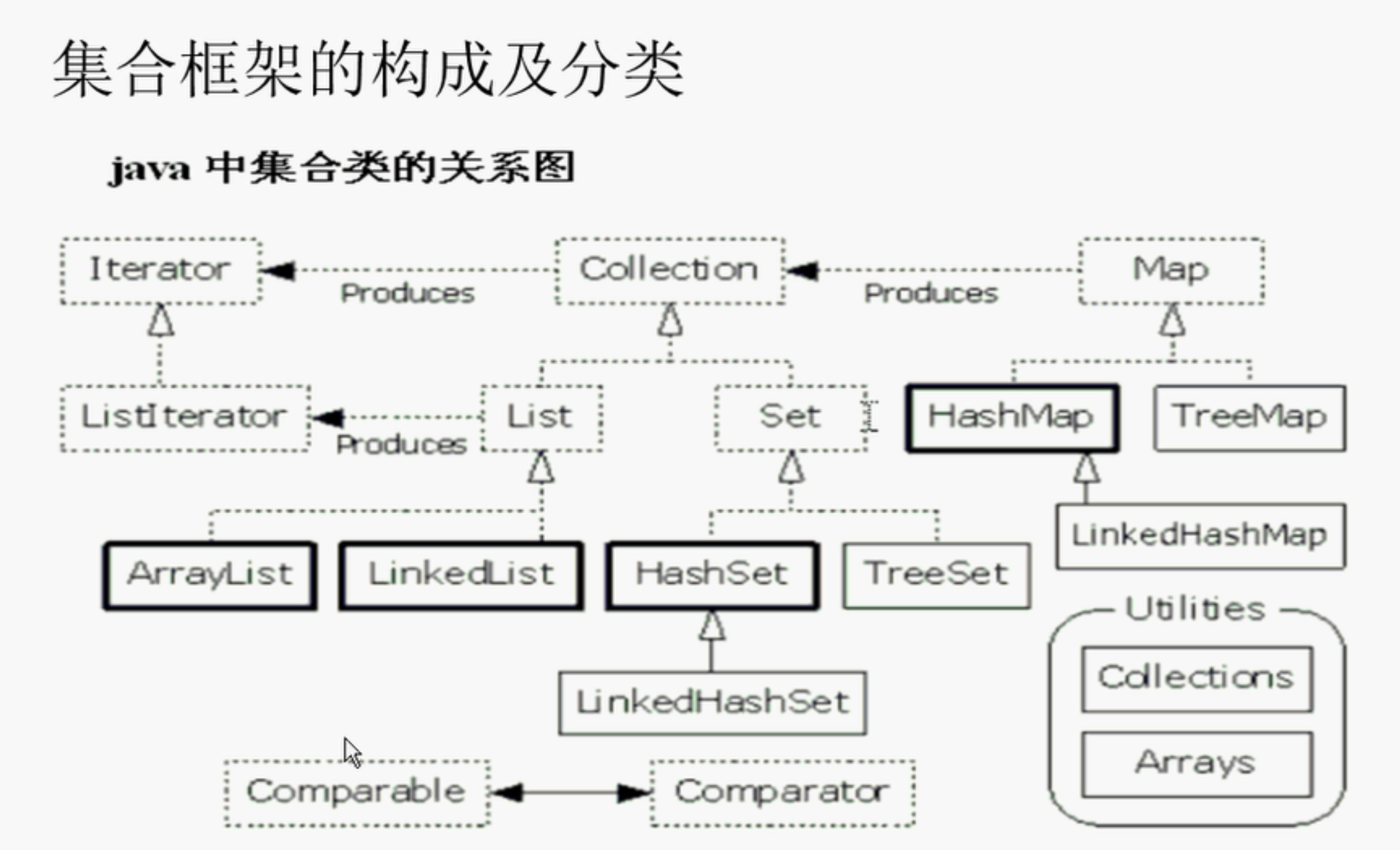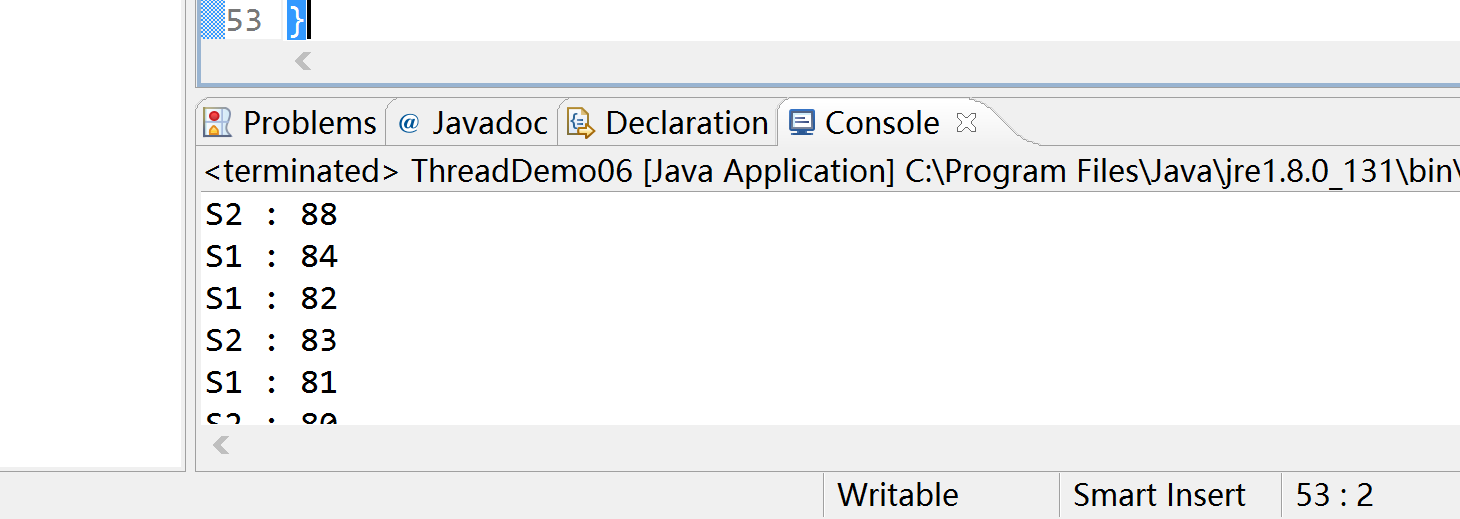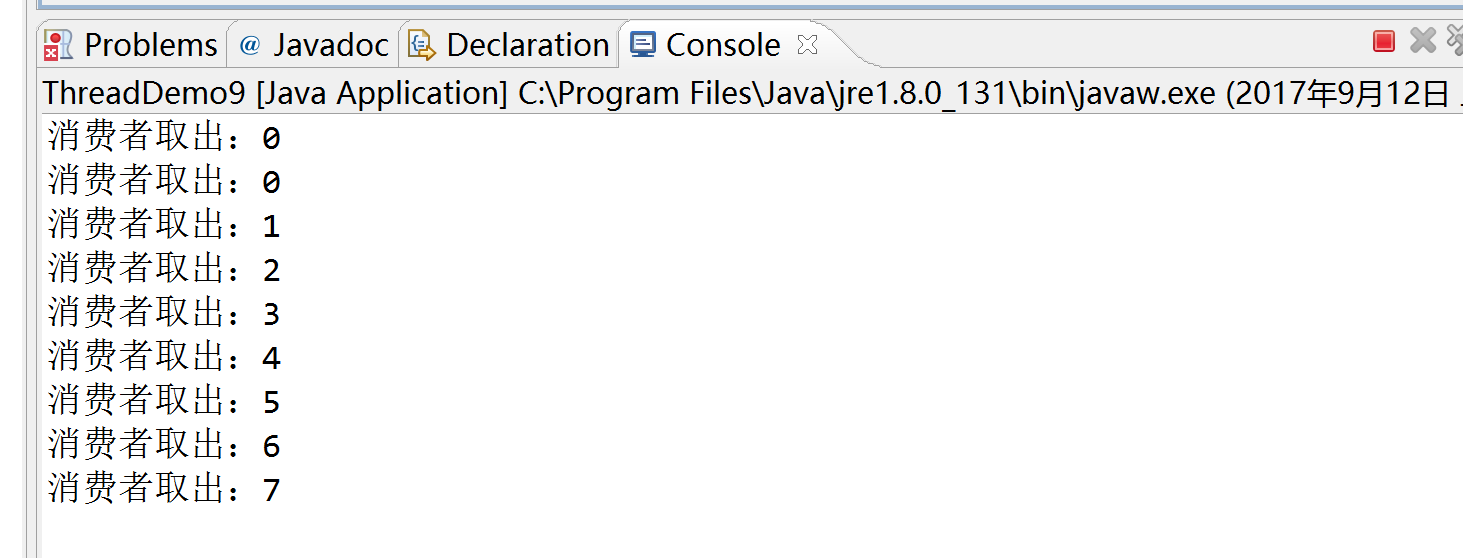@zhangyy
2020-12-04T01:27:47.000000Z
字数 17387
阅读 420
Java的多线程
Java基础系列
一: Java的多线程
1.1 应用程序
进程:1. 运行时(runtime)应用程序。2. 进程之间的内存不是共享(独占)3. 进程间的通讯使用的是socket (套接字)多线程:1. 进程内并发执行的代码段。2. 线程之间共享内存。3. 创建灵活响应的桌面程序4. 每个运行着的线程对应一个stack5. 应用程序至少有一个线程(主线程 main)java.lang.Thread-----------------------1. Thread.yield()方法2. Thread.sleep()方法让当前进程休眠所需要的毫秒数
1.2 创建线程的方式:
继承Thread 类:1. 子类覆盖父类中的run 方法,的代码存放在run 中。2. 建立子类对象的同时线程也被创建。3. 通过调用start 方法开启线程。
package com.learnjava.day08;public class ThreadDemo01 {public static void main(String[] args) {// TODO Auto-generated method stubMyThread m = new MyThread();m.start();YouThread y = new YouThread();y.start();}}// 线程 一:class MyThread extends Thread{public void run() {for(; ;) {System.out.println("hello world -1");}}}// 线程二:class YouThread extends Thread{public void run() {for(; ;) {System.out.println("hello world - 2");}}}

java.lang.Thread----1. Thread.yield()方法让当前线程让出cpu的抢占权,具有谦让的意思,瞬时动作。2. Thread.sleep();让当前线程休眠指定毫秒数。释放cpu 的强占权 和锁旗标没有关系3. Thread.join()当前线程等待指定的线程结束后才能继续运行Thread t = ....t.join();4.daemon守护,服务员。为其他线程提供服务器的线程。若进程中剩余的线程都是守护线程的化,则进程终止了。Thread.setDaemon(true);5. ---原子性操作6.线程间通讯,共享资源的问题锁,防止并发访问,由并行改为串行。参照物的锁旗标// 同步代码块:synchronized{.....}同步代码块执行期间,线程始终持有对象的监控权,其他线程只能等待,处于阻塞状态。7.同步方法是以当前所在对象做锁旗标synchronized(this) == 同步方法8. 同步静态方法:使用类做为同步的标记public static synchronized xxx(){......}
package com.learnjava.day08;public class ThreadDemo02 {public static void main(String[] args) {MyThread m1 = new MyThread("Thread-1");MyThread m2 = new MyThread("Thread-2");m1.start();m2.start();}}class MyThread extends Thread{private String name ;public MyThread (String name) {this.name = name;}public void run() {for(;;) {System.out.println(name);//yield.放弃,谦让Thread.yield();}}}
package com.learnjava.day08;public class ThreadDemo03 {public static void main(String[] args) throws Exception {// TODO Auto-generated method stubPlayer p1 = new Player("tom",3000);Player p2 = new Player("jack",2500);Player p3 = new Player("harry",2000);Player p4 = new Player("natty",1500);p1.start();p2.start();p3.start();p4.start();p1.join();p2.join();p3.join();p4.join();System.out.println("开局。。。。");}}class Player extends Thread {private String name;private int time;public Player (String name ,int time) {this.name = name;this.time = time;}public void run() {System.out.println(name + "出发了.....");try {Thread.sleep(time);} catch (Exception e) {// TODO Auto-generated catch block}System.out.println(name + "到了...耗时"+time);;}}
package com.learnjava.day08;public class ThreadDemo04 {public static void main(String[] args) {Box b1 = new Box("No1", 3000);Box b2 = new Box("No2",7000);Waiter w = new Waiter();w.setDaemon(true);b1.start();b2.start();w.start();}}class Box extends Thread {private String no ;private int time;public Box(String no ,int time) {this.no= no ;this.time = time;}public void run() {System.out.println(no+ "包房开始消费");try {Thread.sleep(time);} catch (Exception e) {}System.out.println(no + "号包房消费时间:"+ time+ ",结束消费!");}}// 守护线程class Waiter extends Thread{public void run() {while (true) {System.out.println(new java.util.Date());try {Thread.sleep(1000);} catch (Exception e) {}}}}
package com.learnjava.day08;public class ThreadDemo05 {public static void main(String[] args) {// TODO Auto-generated method stubSaler s1 = new Saler("S1");Saler s2 = new Saler("S2");s1.start();s2.start();}}class Saler extends Thread{static int tickets = 100;private String name ;public Saler (String name) {this.name = name;}public void run() {while (tickets >0) {System.out.println(name + " : " + (tickets --));}}}
package com.learnjava.day08;public class ThreadDemo06 {public static void main(String[] args) {// TODO Auto-generated method stubSaler s1 = new Saler("S1");Saler s2 = new Saler("S2");s1.start();s2.start();}}class Saler extends Thread{static int tickets = 100;static Object lock = new Object();private String name ;public Saler (String name) {this.name = name;}public void run() {while (true) {int t = getTicket();if (t == -1) {return;}else {System.out.println(name + " : " + t);}}}// 取票public int getTicket() {// 同步代码块synchronized (lock) {int t = tickets ;tickets = tickets -1;return t <1 ? -1 : t ;}}}
package com.learnjava.day08;public class ThreadDemo7 {public static void main(String[] args) {// TODO Auto-generated method stubObject lock = new Object();Saler s1 = new Saler("S1",lock);Saler s2 = new Saler("S2",lock);s1.start();s2.start();}}// 售票员class Saler extends Thread{static int tickets = 100;Object lock ;private String name ;public Saler (String name, Object lock) {this.name = name;this.lock = lock;}public void run() {while (true) {int t = getTicket();if (t == -1) {return;}else {System.out.println(name + " : " + t);}}}// 取票public int getTicket() {// 同步代码块synchronized (lock) {int t = tickets ;tickets = tickets -1;return t <1 ? -1 : t ;}}}
package com.learnjava.day08;public class ThreadDemo8 {public static void main(String[] args) {// TODO Auto-generated method stubTicketPool pool = new TicketPool();Saler s1 = new Saler("S-1", pool);Saler s2 = new Saler("S-2", pool);Saler s3 = new Saler("S-3", pool);s1.start();s2.start();s3.start();}}class Saler extends Thread{private String name ;private TicketPool pool;public Saler (String name , TicketPool pool) {this.name = name;this.pool = pool;}public void run() {while(true) {int no = pool.getTicket();if(no == 0) {return;}else {System.out.println(name + ": " + no);}}}}// 票池class TicketPool {private int tickets = 200;//取票public int getTicket() {// 同步代码块,以票池本身作为锁旗标synchronized (this) {int temp = tickets;tickets = tickets -1 ;return temp > 0 ? temp :0;}}}
package com.learnjava.day08;public class ThreadDemo8 {public static void main(String[] args) {// TODO Auto-generated method stub//TicketPool pool = new TicketPool();Saler s1 = new Saler("S-1");Saler s2 = new Saler("S-2");Saler s3 = new Saler("S-3");s1.start();s2.start();s3.start();}}class Saler extends Thread{private String name ;public Saler (String name) {this.name = name;}public void run() {while(true) {int no = TicketPool.getTicket();if(no == 0) {return;}else {System.out.println(name + ": " + no);}}}}// 票池class TicketPool {private static int tickets = 100;public synchronized static int getTicket() {// 同步代码块,以票池本身作为锁旗标//synchronized (this) {int temp = tickets;tickets = tickets -1 ;return temp > 0 ? temp :0;// }}}
二: Java 的集合:
list : 列表java.util.****java.util.List<Integer>list = new java.util.Arraylist();
9. wait让当前线程进入锁旗标的等待队列,释放cpu 抢占权 还释放锁旗标的监控权。解决死锁的问题方式。Thread.sleep() 释放cpu 的抢占权,和锁旗标没有关系。10. notifyall() 通知所有线程可以抢占cpu和 锁旗标监控权。

public class ThreadDemo9 {public static void main(String[] args) {java.util.List<Integer> list = new java.util.ArrayList<>();Productor p = new Productor("生产者", list);Consumer c = new Consumer("消费者", list);p.start();c.start();}}// 生产者class Productor extends Thread{private String name ;private java.util.List<Integer> list;public Productor(String name , java.util.List<Integer>list) {this.name = name;this.list = list;}public void run() {int i = 0;while (true) {list.add(new Integer(i++));}}}//消费者class Consumer extends Thread {private String name ;private java.util.List<Integer> list;public Consumer(String name , java.util.List<Integer>list) {this.name = name;this.list = list;}public void run() {while (true) {if (list.size()> 0) {int i = list.remove(0);try {Thread.sleep(2000);} catch (Exception e) {}System.out.println(name + "取出:" + i);}}}}
package com.learnjava.day08;public class ThreadDemo10 {public static void main(String[] args) {//集合://java.util.List<Integer> list = new java.util.ArrayList<Integer>();//定义一个poolPool pool = new Pool();Productor p = new Productor("add", pool);Consumer c = new Consumer("remove", pool);p.start();c.start();}}// 生产者class Productor extends Thread {private String name ;// private java.util.List<Integer> list;private Pool pool;public Productor (String name ,Pool pool ) {this.name = name ;this.pool = pool ;}public void run() {int i = 0;while (true) {// 增加// 生产比较快的方式pool.add(i++);System.out.println("add:" + i + " ");}}}//消费者class Consumer extends Thread {private String name ;// private java.util.List<Integer> list;private Pool pool;public Consumer (String name ,Pool pool ) {this.name = name ;this.pool = pool ;}public void run() {while (true) {int i = pool.remove();try {Thread.sleep(100);} catch (Exception e) {e.printStackTrace();}System.out.println("remove:"+ i);}}}class Pool {private java.util.List<Integer> list = new java.util.ArrayList<Integer>();// 最大值:private int Max = 100;// 添加元素public void add (int n) {synchronized (this) {try {if(list.size() >= Max) {this.wait();}else {list.add(n);this.notify();}} catch (Exception e) {// TODO: handle exceptione.printStackTrace();}}}// 删除元素public int remove() {synchronized (this) {try {if(list.size() == 0) {this.wait();}else {int i = list.remove(0);this.notify();return i ;}} catch (Exception e) {e.printStackTrace();}}return -1 ;}}
package com.learnjava.day08;public class ThreadDemo10 {public static void main(String[] args) {//集合://java.util.List<Integer> list = new java.util.ArrayList<Integer>();//定义一个poolPool pool = new Pool();Productor p1 = new Productor("add", pool);// Productor p2 = new Productor("add", pool);Consumer c1 = new Consumer("remove", pool);Consumer c2 = new Consumer("remove", pool);p1.start();// p2.start();c1.start();c2.start();}}// 生产者class Productor extends Thread {int i = 0;private String name ;// private java.util.List<Integer> list;private Pool pool;public Productor (String name ,Pool pool ) {this.name = name ;this.pool = pool ;}public void run() {//int i = 0;while (true) {// 增加// 生产比较快的方式pool.add(i++);System.out.println("add:" + i + " ");}}}//消费者class Consumer extends Thread {private String name ;// private java.util.List<Integer> list;private Pool pool;public Consumer (String name ,Pool pool ) {this.name = name ;this.pool = pool ;}public void run() {while (true) {int i = pool.remove();try {Thread.sleep(100);} catch (Exception e) {e.printStackTrace();}System.out.println("remove:"+ i);}}}class Pool {private java.util.List<Integer> list = new java.util.ArrayList<Integer>();// 最大值:private int Max = 100;// 添加元素public void add (int n) {synchronized (this) {try {if(list.size() >= Max) {this.wait();}else {list.add(n);System.out.println("size:" + list.size());this.notify();}} catch (Exception e) {// TODO: handle exceptione.printStackTrace();}}}// 删除元素public int remove() {synchronized (this) {try {if(list.size() == 0) {this.wait();}else {int i = list.remove(0);this.notify();return i ;}} catch (Exception e) {e.printStackTrace();}}return -1 ;}}
package com.learnjava.day08;public class ThreadDemo11 {public static void main(String[] args) {// 创建篮子Basket basket = new Basket();for (int i = 1 ; i <=40 ; i++ ) {new Worker("Worker -" + i , basket).start();}}}// 定义工人类class Worker extends Thread {private String name ;private static int Max = 3; // 定义工人吃馒头的最大数private int count ;private Basket basket;public Worker (String name , Basket basket) {this.name = name ;this.basket = basket;}public void run() {while (true) {//1.判断是否吃饱了if (count >=Max) {return;}//2. 去 取馒头int no = basket.getManTou();if (no == 0) {return ;}// 3. 拿到馒头了count ++ ;System.out.println(name+ ":" +no);}}}//篮子class Basket{private int count = 100 ;//同步方法,以当前对象做为锁旗标。public synchronized int getManTou() {int temp = count ;count --;return temp > 0 ? temp : 0;}}
package com.learnjava.day08;public class ThreadDemo12 {public static void main(String[] args) {HoneyPot honeypot = new HoneyPot();Bear b1 = new Bear("熊大", honeypot);Bear b2 = new Bear("熊二", honeypot);for(int i = 1 ; i <=100 ; i++) {new Bee("Bee-" + i ,honeypot).start();}b1.start();b2.start();}}class Bee extends Thread{private String name ;private HoneyPot honeypot ;public Bee (String name,HoneyPot honeypot ) {this.name = name ;this.honeypot = honeypot;}public void run() {while (true) {int n = honeypot.add();System.out.println(name + "生产了蜂蜜, honeypot量:" + n);}}}class Bear extends Thread{private String name ;private HoneyPot honeypot ;public Bear (String name,HoneyPot honeypot ) {this.name = name ;this.honeypot = honeypot;}public void run() {while (true) {honeypot.remove();System.out.println(name + "吃掉了蜂蜜:20!");}}}class HoneyPot{private int Max = 20 ;private int count ;//添加 蜂蜜 +1public synchronized int add () {while(count >= Max) {try {this.notify();this.wait();} catch (InterruptedException e) {// TODO Auto-generated catch blocke.printStackTrace();}}return ++ count ;}// 移除 -20public synchronized void remove() {while (count < Max) {try {this.wait();} catch (Exception e) {// TODO Auto-generated catch block// e.printStackTrace();}}count = 0;this.notify();}}
三: Runnable 方法
### 3.1 Runable 方法
java.lang.Runnable----1. 接口2. public void run();3. 提供现有类实现线程功能;4. 使用Runnable 对象创建线程new Thread(Runnable r).start()
3.2 线程的四中状态:

package com.learnjava.day08;public class ThreadDemo13 {public static void main(String[] args) {// TODO Auto-generated method stubnew Thread(new Dog()).start();}}class Animal {private String name;/*** @return the name*/public String getName() {return name;}/*** @param name the name to set*/public void setName(String name) {this.name = name;}}class Dog extends Animal implements Runnable {public void eat () {System.out.println("like bone!");}public void run() {eat();}}
3.3: IDE 集成开发环境
IDE 集成开发环境integrate development environmenteclipse:----1. 日蚀2. netbeans3. idea4. borland jbuilder5.透视图6.视图view
3.4 线程的状态
new // 尚未运行runnable // 运行台blocked // 阻塞状态等待监视器的锁定权Synchronized(this){}waiting // 等待状态(无限等待)一个线程在等另一个线程特定的操作timed waiting //限时等待,等待指定的时间terminated //线程退出之后终止sleep休眠状态


1、新建状态(New):新创建了一个线程对象。2、就绪状态(Runnable):线程对象创建后,其他线程调用了该对象的start()方法。该状态的线程位于可运行线程池中,变得可运行,等待获取CPU的使用权。3、运行状态(Running):就绪状态的线程获取了CPU,执行程序代码。4、阻塞状态(Blocked):阻塞状态是线程因为某种原因放弃CPU使用权,暂时停止运行。直到线程进入就绪状态,才有机会转到运行状态。阻塞的情况分三种:(一)、等待阻塞:运行的线程执行wait()方法,JVM会把该线程放入等待池中。(二)、同步阻塞:运行的线程在获取对象的同步锁时,若该同步锁被别的线程占用,则JVM会把该线程放入锁池中。(三)、其他阻塞:运行的线程执行sleep()或join()方法,或者发出了I/O请求时,JVM会把该线程置为阻塞状态。当sleep()状态超时、join()等待线程终止或者超时、或者I/O处理完毕时,线程重新转入就绪状态。5、死亡状态(Dead):线程执行完了或者因异常退出了run()方法,该线程结束生命周期。
3.5 String 类:
String1. 常量2. 字符串池3. “abc” + "cdf"4. 字符有编码,charset.5. ide 下的默认字符集设置的就是项目编码,和字符集是一个概念6. 字符集GB2312 中文字符集GBK gb2312 加强版BIG-5 繁体字符集ISO-8859-1 西欧码表UTF-8 国际化编码,可以表示任意文字gbkascii < big-5 < utf-8iso-8859-17. 字符在内存中存储的都是unicode码c = '\u0098'c = '中';8. 乱码过程String str = "a 中 b";str.getBytes();9. 字符串遍解码:编码(encode) : string ---> byte[],str.getByte();解码(decode):byte[] --> string ,new String(byte[] ,charset)// 字符集10. stringBuffer-1.字符串缓存区-2.mutable,可变的-3.java.lang.abstractStringBulder---java.lang.StringBuffer-4.字符串安全的方法StringBuilder :------1. 字符串构建器2. mutable 可变的3. java.lang.AbstractStringBuilder{ char[] value}--- java.lang.StringBuilder4.不是线程安全的。Java的基本数据类型:---1. 数字byte Byteshort Shortint Integerlong Longfloat Floatdouble Double2. boolean Boolean3. char Characterbulider 模式------1. java 设计模式之一包装类与基本数据类型的区别----1. 基本数值类型的默认值是 02. 包装类的默认值是null3. 基本类型无法表达null 的概念4. 基本类型不是对象5.包装类是对象6. 参与运算基本类型可以直接参与运算包装类是对象,不能直接参与运算。Integer a = new Integer(12);Integer b = new Integer(13);a.intValue() + b.intValue() ; //自动拆箱a.intValue() + b.intvalue();int i = 6 ,j =7 ;i+j;包装自动装箱:----将基本类型自动转换成包装类对象自动拆箱----将包装类对象自动转换成基本类型-----1. java.lang.String2. java.lang.Integer3. 常量String name = "xxxx";name = "ddd"for (i < 10000){name = name + "" + i;}byte b = (int) 1234;String str = 123 + " ";Object o = new Dog();Dog d = (Dog)o ;4. 创建String 区别// 一个对象String str1 = " abc";// 两个对象String str2 = new String(abc);5.split();切割字符串,形成String数组“hello world” ,“abc” .split (","); 最后的,不生效6.String.substring();子串//beginIndex : int// endindex : int“hello world”.substring(beginIndex,endIndex);"hello world".substring(6,10);// 包头不包尾
package com.learnjava.day08;public class StringDemo01 {public static void main(String[] args) {String str0 = 123 + " " ;String str = "Hello world world";//串长度,字符的个数System.out.println(str.length());str = "hello world中 ";System.out.println(str.length());//指定输出那一个 str.charAt(i)System.out.println(str.charAt(0));//全部输出for(int i = 0 ; i<str.length() ; i++ ) {System.out.println(str.charAt(i));//复制String中的[],产生新的数组,不会影响原来的数组char [] arr = str.toCharArray();//返回字符串在母串中的位置(索引值,以0 为基础)// 指定开始的位置int pos = str.indexOf("world",7);System.out.println(pos);String s1 = "3Month";String s2 = "3Year";String s3 = "3Day";//判断是以指定的字符结尾:System.out.println(s1.endsWith("th"));//判断是以指定的字符开头System.out.println(s2.startsWith("3"));str = " hello world";String [] strr = str.split(" ");System.out.println(strr.length);}}}
3.6编码表
1.ascll 美国标准信息交换码。用一个字节的7 位 可以表示2. iso 8859-1: 拉丁码表,欧洲码表用一个之间的8位表示,无法存储杭州,或者只取了汉子的半。使用? 代替,即编码为63.3. GB2312: 中国的中文编码表4. GBK: 中过的中午编码表升级,融合了更多的中文文字符号。5.unicode: 国际标准吗,融合了多种文字。所有文字都用两个字节来表示,Java 语言使用的就是unicode6. utf-8: 醉多用三个字节来表示一个字符
package com.learnjava.day08;import java.io.UnsupportedEncodingException;public class ZiFu {public static void main(String[] args) throws Exception {char a = 97;a = 'a';a= '\uFFFF';int ii =5;String str = "a 中 b";byte [] bytes = str.getBytes("GBK");System.out.println(bytes.length);String NewStr = new String(bytes,"GBK");System.out.println(NewStr);}}
3.7 集合数据
数组:---1. 元素 类型 必须相同2. 长度固定3. 地址连续4. 通过下标,以0为基址5. null指针异常、索引越界异常
集合1.容器2. 长度可变3. 只能存放对象4. 元素可以不相同5. 集合都是在类当中list----interface java.lang.Iterable/|\| ----java.util.collection/|\| --- interface java.util.list/|\| --- class java.util.ArryList2.可以存放重复元素3. 元素存放时有序4. Arrylist 查询块慢读取list.add ()list.get(int index)list.remove(int index)list.clear();5. likedList链表通过手拉手实现对象引用存储速度快,查询慢set-----interface java.lang.Iterable/|\| ----java.util.collection/|\| --- interface java.util.set2. 元素不能重复3. 元素的存储是无序常用三种集合:ArrayListHashSetHashMap没有一个是线程安全的list接口中常用类1. Vector : 线程安全,但速度慢,已经被ArrayList 取代2. ArrayList: 线程不安全,查询速度快。3. LinkedList: 链表结构,增删速度快取出list 集合中元素的方式:- get (int index)- iterator(); 通过迭代方法获取迭代器取对象。string----1. == 判断的是对象的内存地址,不是内容equals---1. 判断对象的内容是不是相同。
集合框架的构成分类

package com.learnjava.day10;public class Person {private String name ;private int age ;public String getName() {return name;}public void setName(String name) {this.name = name;}public int getAge() {return age;}public void setAge(int age) {this.age = age;}public Person() {}public Person(String name, int age) {this.name = name;this.age = age;}}
package com.learnjava.day10;import java.util.ArrayList;import java.util.Iterator;import java.util.List;public class PersonDemo01 {public static void main(String[] args) {List<Person> list = new ArrayList<Person>();Person p = null;for(int i = 0 ; i<100 ; i++) {p = new Person();p.setName("tom" + i);p.setAge(i%100);list.add(p);}Iterator<Person> it = list.iterator();while(it.hasNext()) {Person p1 = it.next();System.out.println("Person{" + p1.getName() + "," + p1.getAge() + "}");}}}

package com.learnjava.day10;import java.util.LinkedList;import java.util.List;public class LinkedListDemo01 {public static void main(String[] args) {List<String> list = new LinkedList<String>();list.add("hadoop");list.add(0, "spark");list.add("hive");for(int i = 0 ; i <list.size() ; i++ ) {System.out.println(list.get(i));}}}
package com.learnjava.day10;public class StringDemo01 {public static void main(String[] args) {String s1 = "abc";String s2 = "abc";String s3 = new String("abc");String s4 = new String("abc");Person p1 = new Person("tom",1);Person p2 = new Person("tom",1);System.out.println(s1==s2);System.out.println(s3==s4);System.out.println(s3.equals(s4));System.out.println(p1 == p2);System.out.println(p1.equals(p2));}}


















